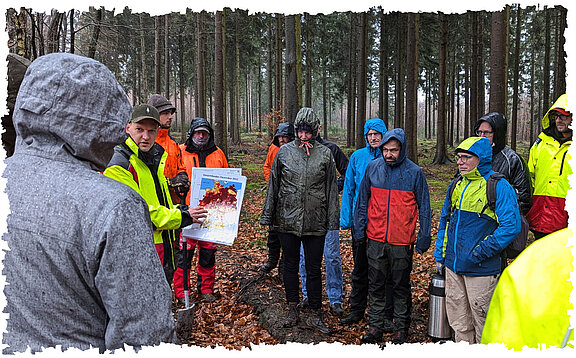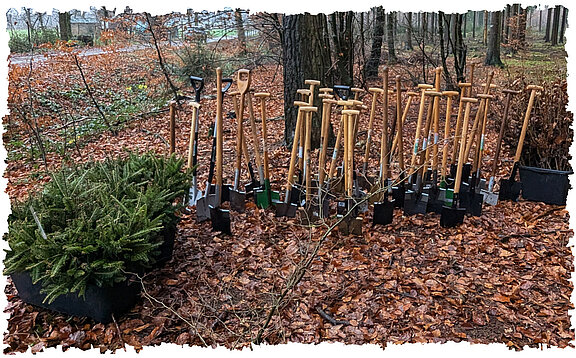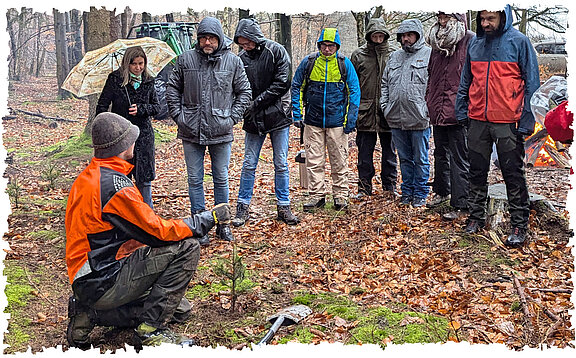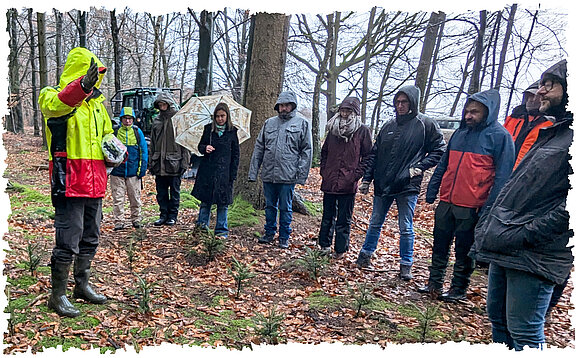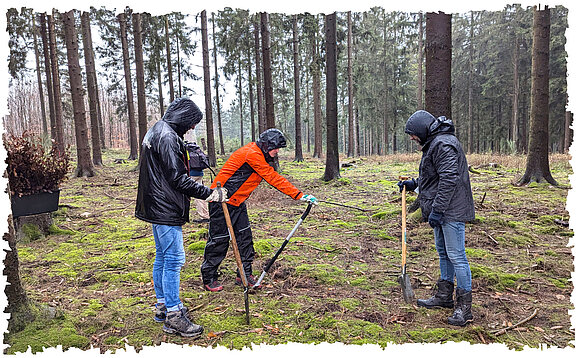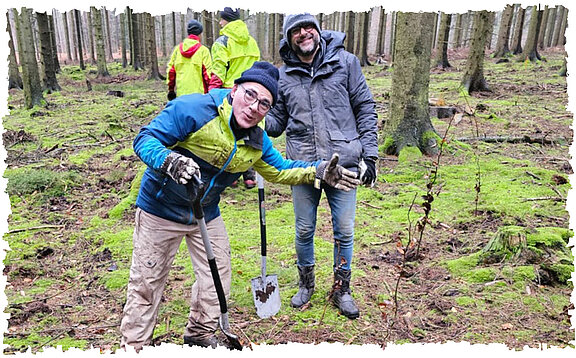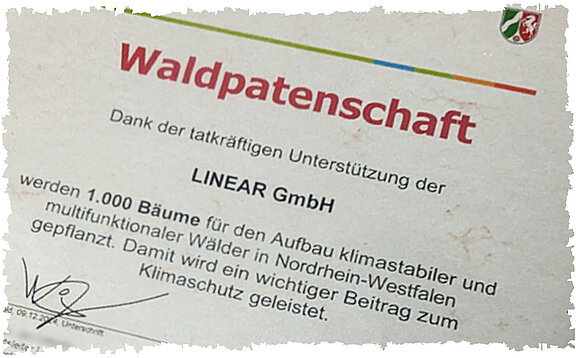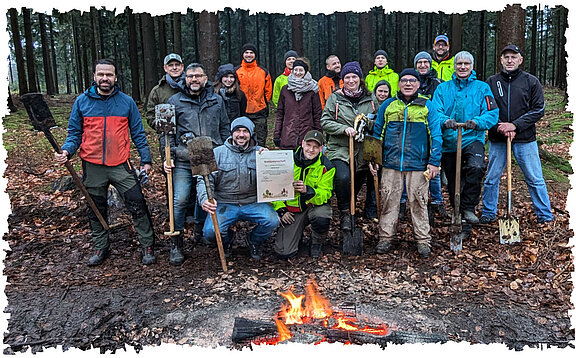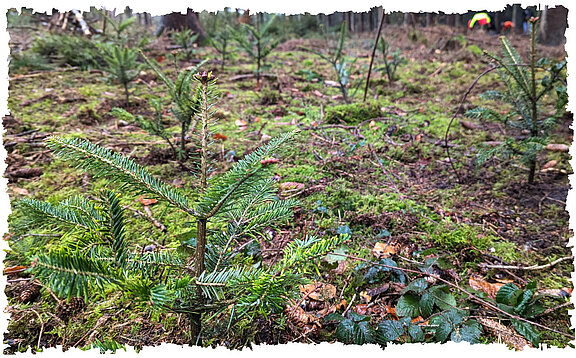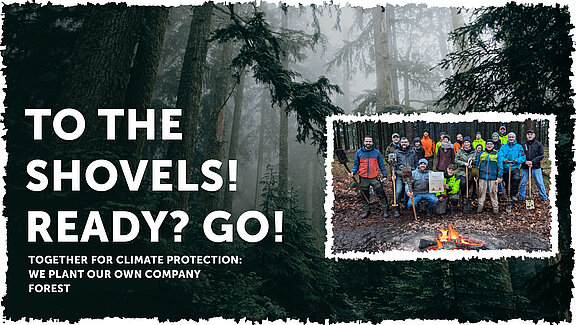
In the spring issue of our LINEAR AKTUELL (1|24), which was published last year, we already reported on our cooperation with the Cologne-based company Planted. As a reminder: Planted pursues the vision of inspiring people to protect the climate in a positive way. Their "all-in-one sustainability platform" supports companies in determining their own CO2 footprint, identifying internal CO2 hotspots and developing reduction options.
In the course of our collaboration, our company's internal life cycle assessment has already been drawn up and reduction measures developed. However, as already mentioned in the article "CO2 strategy meets local environmental protection", we wanted to go one step further. On 9 December 2024, the time had come: our internal LINEAR planting event with Planted took place with the aim of planting our own company forest.
We gathered punctually at 11.00 a.m. in front of our company building in Aachen. We travelled together in the hired bus towards Hürtgenwald, a wooded area in the northern Eifel on the border between Germany and Belgium, in the district of Düren (North Rhine-Westphalia). After a good 50-minute drive, we arrived at the Asterbach car park, our previously agreed meeting point. There we were welcomed by Mr Wiesmeyer, head of the state-owned forestry operation at the Rureifel-Jülicher Börde regional forestry office. He accompanied us to a section of forest about a kilometre away, where his team was already waiting for us.
After a brief welcome around the warming campfire that had been lit earlier, Mr Wiesmeyer gave us a revealing insight into the current state of Germany's forests. It may not be obvious at first glance, but the past few years have been characterised by extreme drought, which has destabilised the forest soils. As a result, many trees are no longer secure and can easily be uprooted in increasingly severe storms. According to the Federal Government's Forest Condition Report, German forests are in worse shape than ever before. Three out of four trees have sparse crowns - a sign of health problems, which is why the forestry office is working hard to reforest our forests with climate-resistant tree species.
But what does "climate-resistant" or "climate-stable" mean? This refers to tree species that are adapted to the specific site conditions and are better able to cope with the challenges of climate change, such as drought and storms. They usually develop deeper roots, which help them to access water better in summer and to withstand storms in autumn through increased stability. The forestry office had already analysed the site conditions in advance, so copper beeches and silver firs were selected for our company forest. These tree species are not only well adapted to the region, but also contribute to the development of a stable mixed forest and create sustainable added value in the long term. A total of 1,000 seedlings were waiting for us to plant them in the ground.
"A considerable number - but planting a seedling can't be that difficult," we thought. But we were wrong! Before we were allowed to break ground, we were instructed in the correct planting technique. Only certain areas, previously marked with a stick, were allowed to be planted. Groups of 24 seedlings of the same species had to be formed and planted at a distance of one metre from each other in the order 4:5:6:5:4. The depth of the planting holes was also crucial: the spade head had to disappear completely into the ground in order to give the young tree a secure hold, protect the roots and still leave them enough space. The soil also had to be free of moss and stones so as not to hinder root growth. Once the first seedling had been placed, the soil was sealed with a second spade tap, the remaining soil was spread around the trunk, pressed down with the foot and checked by gently pulling on the crown to ensure that the tree was firmly anchored in the ground.
Why all this effort? A legitimate question! The young trees not only compete with mature plants for nutrients and light, but also with each other. With this grouping and the close proximity to each other, the "survival of the fittest" principle applies even more strongly. On the one hand, it ensures that the trees sprout as quickly as possible instead of spreading out and that the strongest seedlings prevail. In addition to the competing plants, the poor condition of the forest soil, as described at the beginning, also plays a decisive role in development. In addition, the upper buds of the young plants are a favoured food source for deer and stags. Unfortunately, vandalism is also a recurring problem, with already planted seedlings being deliberately destroyed by human hands. If conditions allow, one of the 24 seedlings will manage to grow into a strong, resilient tree. This figure sounds quite sobering. But when you realise that every third tree in Germany is sick and the existing monocultures in our forests are not helping to improve the state of health, a climate-stable tree is still better than none. And who knows - perhaps one or two seedlings from the individual groups will even manage to grow into stately trees. But this fact alone was a further incentive for us to get actively involved.
Once the theory had been clearly explained by one of the foresters, it was time for the practical part. Equipped with spades and seedlings, we spread out in groups in the designated areas. But it soon became clear that planting was more strenuous than expected. The Eifel soil is interspersed with slate rock and the roots of mature trees, which made digging considerably more difficult. Fortunately, team members from the forestry office were on hand to help and advise us - either with tips on the right technique or with a pickaxe when the spade wasn't enough.
After two hours, we took a break. While we fortified ourselves with the hot drinks we had brought with us and delicious treats from the bakery, we warmed up a little around the campfire and let our soaked layers of clothing dry out a little. Despite the physical exercise, the cold and rain were omnipresent. We then started the final spurt and planted the remaining seedlings in the remaining two hours. In the meantime, the rain had even subsided, which made digging a little more pleasant.
You may be wondering why the event didn't take place in summer. The answer is simple: young trees are in a dormant phase in winter and may only be planted between November and March, depending on the drought conditions. These and many other facts about reforestation were also new to us, which made the event all the more informative.
4.00 pm - four hours in the forest were behind us and the planting event was coming to an end. We gathered around the campfire one last time, where Mr Wiesmeyer ceremoniously presented us with the forest sponsorship certificate for our company forest. With heartfelt thanks to the forestry office team, we said goodbye, returned to the car park where the bus was waiting for us and set off on our return journey to Aachen.
One thing was clear: winter temperatures, persistent rain, difficult ground conditions, mud and dirt could not stop us from going through with this event. The teamwork, the result achieved
and the experience gained made this day an unforgettable experience. And who can claim to have been involved in planting their own company forest?
We now hope that our 1,000 young trees will thrive, contribute to climate protection and strengthen local biodiversity.
We would like to take this opportunity to thank everyone involved once again:
• To Planted - for the organisation and coordination.
• To the team at the forestry office - for their expert support, for answering our questions and for the exciting insights into sustainable reforestation.
• To our LINEAR team - who bravely braved the wet and cool weather to plant our company forest.
By the way: If you would like to visit our company forest, you can do so from the comfort of your office chair. A digital twin of the forest is integrated on our website, which shows the exact location. You can find it on our website in the Social Responsibility section [click here] or at the bottom of this blog post.
All further details and information about Planted, our cooperation and how it came about can be found in the corresponding LINEAR AKTUELL 1|24 article or in the corresponding blog post on our LINEAR blog [click here].
